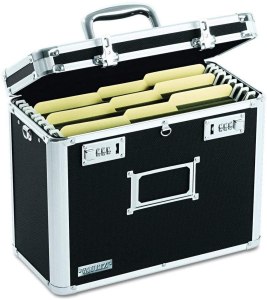
A legacy box is something that contains all your important documents and information your family will need after you pass away or if you become incapacitated. Having everything organized and clearly labeled in one location is important. Talk with your family members and let them know what you plan to include and where the box will be located. Ask them if there is anything they would like you to include, they may have some suggestions or ideas that you have not thought of.
You can store this information in a home safe, safety deposit box or other type of storage container. It would also be useful to keep a digital copy of your information on your computer and online. This ensures that there are multiple copies of everything important.
Gather your original documents and make copies of everything. To create digital copies, scan each document and save it on your computer. Once the documents are saved to your computer you can copy them to an online storage site and an external hard drive. Make sure the people who will have access to your legacy box can also access your computer and online storage site. If you save a copy of the legacy box documents to an external hard drive keep that in the legacy box as well.
Items to Include
Letter
This is a letter to the person who will have access to the legacy box. It is simply a letter explaining what you have included in the legacy box and any instructions you would like to leave.
Will & Power of Attorney
If you have not already created a will you should. It is best to set up an appointment with an attorney who specializes in wills and estates. An attorney can guide you through the entire process making sure everything is in order. A will specifies who inherits your assets and estate after your passing and serves as proof of your final wishes. If there is no will, your estate could be tied up in court causing your survivor’s unneeded stress. Include a copy of your living will, power of attorney, durable power of attorney (DPA) for health care, advance directive and do not resuscitate (DNR)
Funeral Wishes
If you have made your funeral arrangements the documents and instructions should be included. If you have not made arrangements leave a letter indicating your wishes.
Financial Information
Include all documents related to your financial accounts. This can include bank and credit union accounts, loan information and retirement and investment accounts. Include the names of the financial institutions and account numbers.
Insurance Information
Include health care insurance, auto insurance, life insurance, disability insurance and any other coverage you have.
Tax Information
Include copies of your tax returns and property tax information.
Contact Information
Keep a list of any professionals you do business with, such as financial advisors, CPA’s, attorneys, insurance agents and anyone else your survivors may need to contact.
Personal Address Book
Either a digital or hard copy of your address book or contact list.
Medical Records
Include anything related to your medical care. Copies of your medical records, chronic medical conditions you may have, medications you were prescribed, surgeries and procedures you have had, the names of doctors and clinics where you received care and any other relevant information.
Important Documents
Some examples of important documents you want to include are birth certificate, marriage and divorce certificates, Social Security card, driver’s license, passport, family ancestry information, the location of family heirlooms and important historical documents, deeds, titles, military records and anything else that is meaningful to you.
Letters to Your Family & Others
Many people choose to write letters to family and friends to be read after their passing. You may also wish to record a video for your loved ones.
Photos & Videos
Include any photos or videos you would like to pass on.
Monthly Budget
Include a copy of your monthly budget and expenses.
Usernames & Passwords
Use a password manager to store your usernames and passwords. Include instructions on how to access the password manager and what the password is to open the program. In the password manager list the names of the accounts, web addresses, usernames, passwords, email addresses, PIN numbers, answers to your security questions and any other relevant information. Be sure to include the password or passcode for your computer and smartphone.
If you digitalized your documents, include where the digital copies are located and how to access them.
Keys
Include a copy of any keys your family may need. House keys, keys to other homes you own, car keys, safe keys, safety deposit box keys and any other keys they should have.
Safety Deposit Box & Safe
If you have a home safe or safety deposit box leave instructions on how to access them.
Updating
Be sure to update the information in your legacy box regularly. Setup a calendar reminder so you don’t forget.